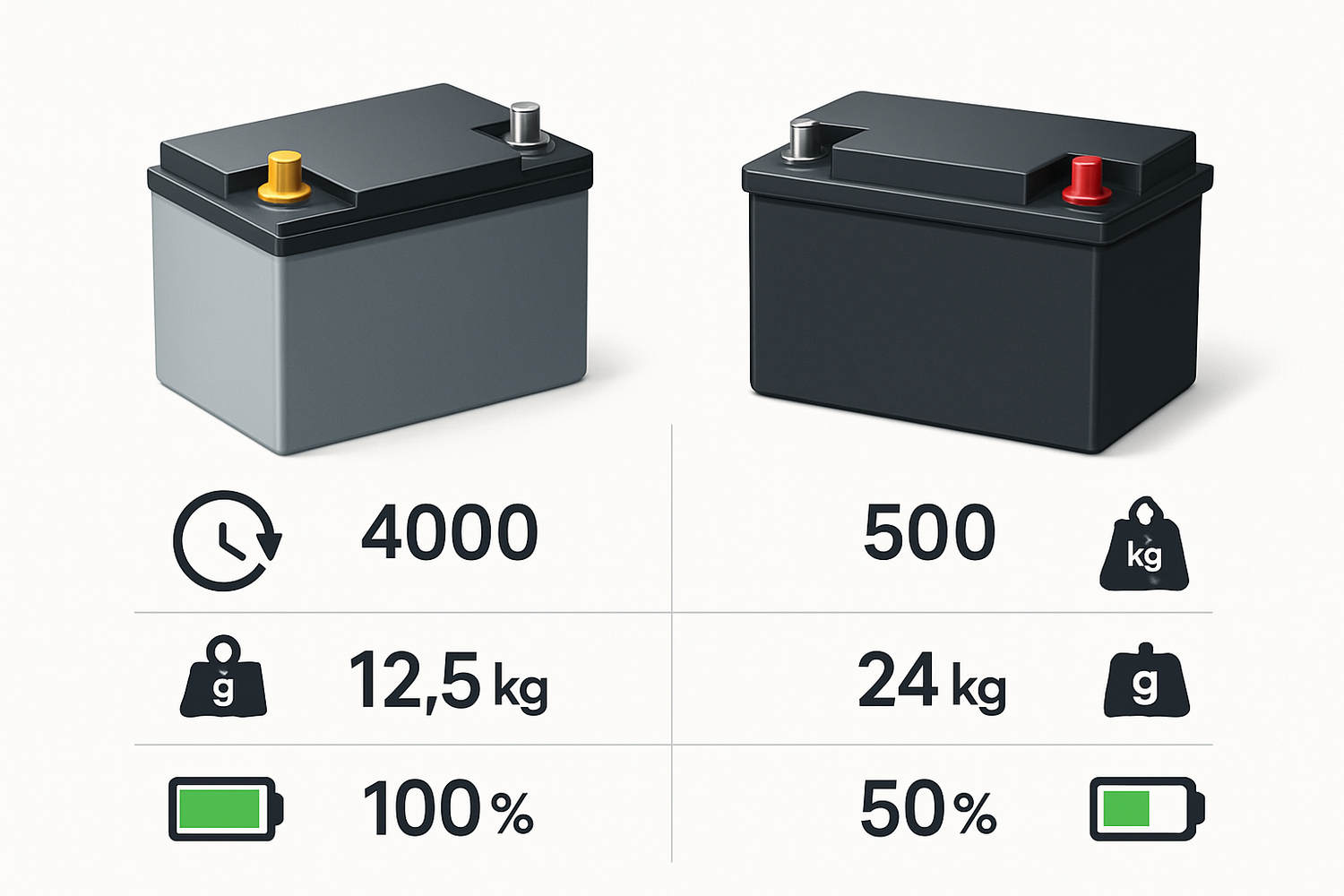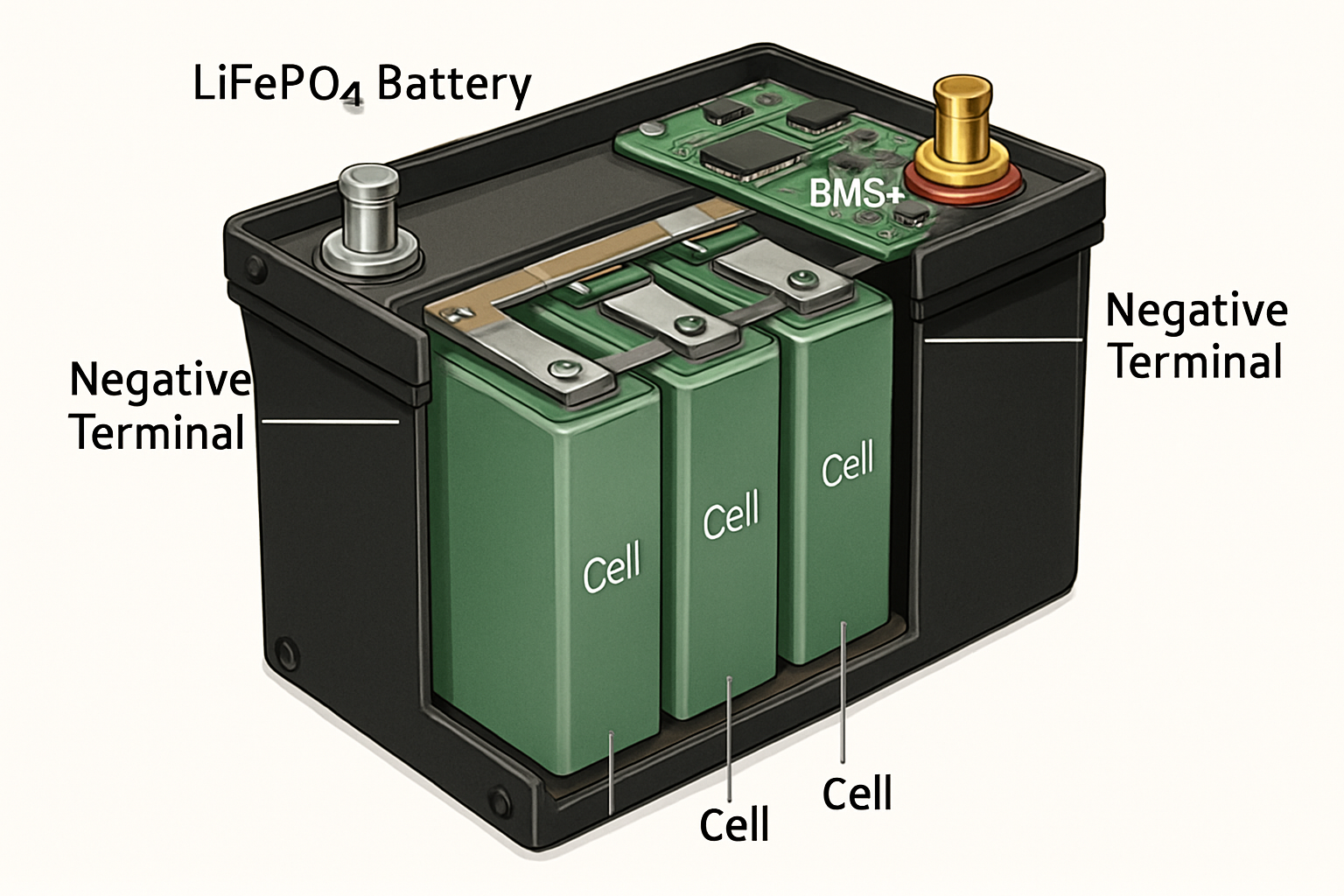For applications that require sustained, reliable power, not all batteries are created equal. While a standard car battery delivers a powerful jolt to start an engine, it cannot handle the demands of providing steady energy over long periods. This is the role of a deep cycle battery, a technology designed for endurance. Among the available options, Lithium Iron Phosphate (LiFePO4) chemistry has emerged as a leading choice, offering significant advantages for everything from home energy storage to recreational vehicles.
Understanding the Fundamentals of Deep Cycle Batteries
What Distinguishes a Deep Cycle Battery?
Think of a deep cycle battery as a marathon runner, while a starter battery is a sprinter. Its primary function is to deliver a consistent current for an extended duration before needing a recharge. This capability is measured by two critical factors: cycle life and Depth of Discharge (DoD). Cycle life refers to the number of charge and discharge cycles a battery can endure before its capacity diminishes significantly. DoD indicates the percentage of the battery's total capacity that can be safely used. A true deep cycle battery is built to be regularly discharged to a high DoD without sustaining damage.
Traditional Deep Cycle Technologies: Lead-Acid
For decades, lead-acid batteries in various forms—including flooded (FLA), sealed (SLA), and absorbed glass mat (AGM)—were the standard for deep cycle applications. They are a proven and affordable technology. However, they come with notable limitations. Lead-acid batteries typically have a shorter cycle life, are sensitive to being discharged too deeply (usually a recommended 50% DoD), are heavy, and can require regular maintenance, such as checking water levels in flooded types.
The Rise of Lithium Iron Phosphate (LiFePO4)
What is a LiFePO4 Battery?
A LiFePO4 battery is a specific type of lithium-ion battery that uses lithium iron phosphate as its cathode material. This chemistry is renowned for its exceptional stability and safety. Unlike other lithium-ion variants that use materials like cobalt, LiFePO4 is non-toxic and composed of more abundant resources, making it a more sustainable choice. Its molecular structure is inherently more robust, significantly reducing the risks associated with overheating and thermal runaway.
Key Advantages of LiFePO4 in Deep Cycle Applications
The chemical and structural properties of LiFePO4 batteries translate into tangible performance benefits, particularly for demanding deep cycle use cases.
- Superior Cycle Life: LiFePO4 batteries can deliver thousands of cycles, often between 3,000 and 5,000, whereas most lead-acid batteries offer only a few hundred. This dramatic difference in longevity means fewer replacements and greater reliability over the system's lifetime.
- High Depth of Discharge (DoD): You can regularly use 80-100% of a LiFePO4 battery's capacity with minimal impact on its lifespan. In contrast, discharging a lead-acid battery beyond 50% can permanently reduce its capacity. This means a 100Ah LiFePO4 battery provides nearly double the usable energy of a 100Ah lead-acid battery.
- Consistent Performance: LiFePO4 batteries maintain a stable voltage output throughout the discharge cycle. This ensures that your appliances and electronics run efficiently without performance dips as the battery drains. They also boast a high round-trip efficiency, often above 95%, meaning less energy is lost during charging and discharging.
- Enhanced Safety: The U.S. Department of Energy has highlighted the importance of safety in battery technology. LiFePO4's stable chemistry makes it highly resistant to thermal runaway, a critical safety feature for installations in homes, RVs, and marine vessels.
LiFePO4 vs. Lead-Acid: A Practical Comparison
Head-to-Head Performance Metrics
When directly compared, the advantages of LiFePO4 technology become clear. The initial investment may be higher, but the long-term performance and value proposition are compelling.
| Feature | LiFePO4 Battery | Lead-Acid Battery (AGM) |
|---|---|---|
| Typical Cycle Life | 3,000 – 5,000+ cycles | 300 – 500 cycles |
| Usable Capacity (DoD) | 80-100% | 50% recommended |
| Round-Trip Efficiency | ~95% | ~80-85% |
| Weight | Significantly Lighter | Heavy |
| Maintenance | None | None (but sensitive to charging) |
| Upfront Cost | Higher | Lower |
Calculating the True Cost of Ownership
Focusing solely on the initial purchase price is misleading. The true value is revealed when considering the lifetime cost. A single LiFePO4 battery can outlast multiple lead-acid replacements, eliminating the cost and hassle of frequent change-outs. When you factor in the greater usable capacity and higher efficiency, the cost per kilowatt-hour over the battery's life is often substantially lower for LiFePO4. For a deeper analysis of storage performance metrics, the Ultimate Reference for Solar Storage Performance provides valuable data on how efficiency impacts long-term costs.
Real-World Applications for LiFePO4 Deep Cycle Batteries
Powering Off-Grid and Solar Energy Systems
The ability to handle deep, frequent cycles makes LiFePO4 ideal for solar energy storage. According to a report from the International Renewable Energy Agency (IRENA), battery storage is a key enabler for integrating renewables into our power systems. LiFePO4 batteries efficiently store excess solar energy generated during the day for use at night, providing a stable and reliable power source for homes and businesses seeking energy independence.
Beyond Stationary Storage: RVs, Marine, and More
In mobile applications, every pound and inch of space matters. The lightweight and compact nature of LiFePO4 batteries makes them a superior choice for RVs, boats, and other recreational vehicles. Their maintenance-free operation and inherent safety provide peace of mind, allowing users to focus on their activities without worrying about battery upkeep or hazardous fumes.
Making the Right Choice for Your Energy Needs
The evidence points to a clear conclusion: for demanding deep cycle applications, LiFePO4 battery technology offers a superior combination of lifespan, usable power, efficiency, and safety. While traditional lead-acid batteries still have a place, the long-term value and reliability of Lithium Iron Phosphate are transforming the landscape of energy storage. Investing in advanced battery technology is a critical step for anyone looking to build a resilient and independent energy solution, whether at home, on the water, or on the open road.
Frequently Asked Questions
Can you use a LiFePO4 battery to start an engine?
While some are designed with high discharge rates, most deep cycle LiFePO4 batteries are optimized for sustained output, not the high cranking amps needed for starting. It's best to use a dedicated starter battery for that purpose.
Do LiFePO4 batteries require a special charger?
Yes, it is highly recommended to use a charger specifically designed for LiFePO4 chemistry. These chargers use the correct voltage profiles and charging algorithms (like CC/CV) to ensure the battery's health, performance, and safety.
Are LiFePO4 batteries safe?
LiFePO4 is widely considered one of the safest lithium-ion chemistries. Its stable chemical structure is highly resistant to thermal runaway and overheating, making it significantly safer than many other lithium-ion variants.
How does temperature affect a LiFePO4 battery?
LiFePO4 batteries perform well across a wide range of temperatures. However, a key consideration is that most should not be charged below freezing (0°C or 32°F) without an integrated heating system, as doing so can cause damage. Many modern batteries include a Battery Management System (BMS) with low-temperature charging protection to prevent this.





Leave a comment
All comments are moderated before being published.
This site is protected by hCaptcha and the hCaptcha Privacy Policy and Terms of Service apply.